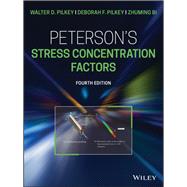The bible of stress concentration factors—updated to reflect today's advances in stress analysis
This book establishes and maintains a system of data classification for all the applications of stress and strain analysis, and expedites their synthesis into CAD applications. Filled with all of the latest developments in stress and strain analysis, this Fourth Edition presents stress concentration factors both graphically and with formulas, and the illustrated index allows readers to identify structures and shapes of interest based on the geometry and loading of the location of a stress concentration factor.
Peterson's Stress Concentration Factors, Fourth Edition includes a thorough introduction of the theory and methods for static and fatigue design, quantification of stress and strain, research on stress concentration factors for weld joints and composite materials, and a new introduction to the systematic stress analysis approach using Finite Element Analysis (FEA). From notches and grooves to shoulder fillets and holes, readers will learn everything they need to know about stress concentration in one single volume.
- Peterson's is the practitioner's go-to stress concentration factors reference
- Includes completely revised introductory chapters on fundamentals of stress analysis; miscellaneous design elements; finite element analysis (FEA) for stress analysis
- Features new research on stress concentration factors related to weld joints and composite materials
- Takes a deep dive into the theory and methods for material characterization, quantification and analysis methods of stress and strain, and static and fatigue design
Peterson's Stress Concentration Factors is an excellent book for all mechanical, civil, and structural engineers, and for all engineering students and researchers.








